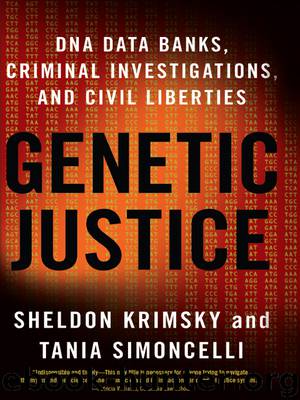Genetic Justice by Sheldon Krimsky

Author:Sheldon Krimsky
Language: eng
Format: epub
Tags: Science/Life Sciences/Genetics and Genomics
Publisher: Columbia University Press
Published: 2011-10-31T04:00:00+00:00
Database Operations
In or around August 2002 the commonwealth government started approaching serious offenders convicted of murder, rape, and sexual offenses against children to collect DNA samples. Routine DNA collection was initiated in some states and territories before this; Victoria began collecting DNA from individuals convicted of serious sex offenses in 1996. A year later Victoria expanded collection to those found guilty of drug trafficking, arson causing death, and aggravated burglary.10 Over time sample collection expanded throughout the states and territories to include “high-volume” crimes, such as breaking and entering.
DNA dragnets have also been conducted in Australia. The first took place in Wee Waa, New South Wales, in 2000 in response to the rape of a 91-year-old woman. Nearly the entire male population of the village (aged 18 to 45) was tested, totaling over 400 samples. Stephen Boney confessed to the crime shortly after his DNA was collected, but before it was processed. Following resolution of the case, all the samples collected from volunteers were destroyed, as required by law.11 Although the dragnet did help resolve the crime, some have pointed out that the individual ultimately convicted was well known to the police, had a history of aggravated rape, and had moved to the neighborhood just before the crime. Therefore, they argue that the individual should have been caught using conventional policing techniques and without having to subject many innocent individuals to testing.12 In addition, the dragnet resulted in significant upset to the community. Those who refused to provide a sample or who expressed concerns were singled out and stigmatized. As a result, the Green Party of New South Wales proposed an amendment to the Crimes (Forensic Procedures) Act 2000 that would have required the police to seek the approval of a magistrate before carrying out a dragnet.13
By early 2003 Australia had established its National Criminal Investigation DNA Database (NCIDD) and its Disaster Victim Identification Database. Both national databases are operated by CrimTrac, an executive agency and a prescribed agency of the commonwealth government. CrimTrac enters into agreements with each state and territory—the participating jurisdictions. These agreements determine the procedures of interjurisdictional access to and sharing of DNA profiles. Amendments to the commonwealth legislation adopted in 2006 stipulated the legal status of the NCIDD as being an “amalgam of state and territory databases.”14
Although the NCIDD went live in 2001, it did not become fully operational until 2007. The delay was primarily due to the need for each state and territory to have passed its own legislation and reach an agreement with the commonwealth government.15 Inconsistencies between the federal legislation and each of the state laws created further obstacles to implementation.
In contrast to the United States, which uses 13 loci for DNA profiles, the Australian forensic units analyze DNA at 9 loci. Police typically obtain buccal swabs, hair and root samples, or blood samples. By June 30, 2007, the NCIDD had a total of 300,624 profiles, of which 111,404 were classified as suspects, 52,963 were serious offenders, 31,446 were offenders, 15,868 were from volunteers for unlimited purposes, and 63,327 were from crime scenes.
Download
This site does not store any files on its server. We only index and link to content provided by other sites. Please contact the content providers to delete copyright contents if any and email us, we'll remove relevant links or contents immediately.
| Anthropology | Archaeology |
| Philosophy | Politics & Government |
| Social Sciences | Sociology |
| Women's Studies |
The Secret History by Donna Tartt(16716)
The Social Justice Warrior Handbook by Lisa De Pasquale(11506)
Thirteen Reasons Why by Jay Asher(7829)
This Is How You Lose Her by Junot Diaz(5826)
Weapons of Math Destruction by Cathy O'Neil(5075)
Zero to One by Peter Thiel(4865)
The Myth of the Strong Leader by Archie Brown(4809)
Promise Me, Dad by Joe Biden(4475)
Beartown by Fredrik Backman(4463)
How Democracies Die by Steven Levitsky & Daniel Ziblatt(4447)
Stone's Rules by Roger Stone(4438)
The Fire Next Time by James Baldwin(4371)
100 Deadly Skills by Clint Emerson(4106)
A Higher Loyalty: Truth, Lies, and Leadership by James Comey(4056)
Rise and Kill First by Ronen Bergman(4041)
The David Icke Guide to the Global Conspiracy (and how to end it) by David Icke(3912)
The Farm by Tom Rob Smith(3893)
Secrecy World by Jake Bernstein(3806)
The Doomsday Machine by Daniel Ellsberg(3754)
